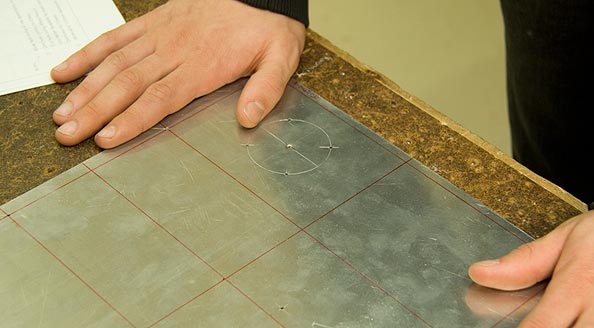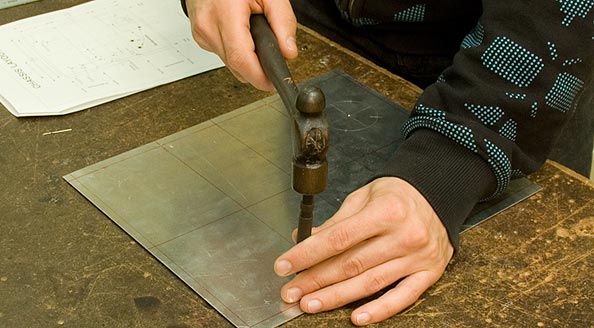Measurement & marking out
Procedure
Inspection
Material should be inspected before use for:
- edges not straight or square
- cracks and surface defects
- warps and twists
- insufficient allowance of metal for machining, filing, etc
- incorrect metal for the required job.
Layout dye
Application of a coating substance can be used so that the marked lines will show clearly. The colour of the coating substance should be in contrast to the surface colour of the work.
- For rough surfaces (such as those on black bar material), chalk rubbed in or water paint is commonly used.
- For machined or finished surfaces, a blue marking out dye can be used.
Marking out lines

Markings on sheet metal
Datum lines
Datum refers to a fixed or starting point, line or surface. A marking out operation will be more accurate if all measurements are from one datum point.
This could be the use of one straight edge of a sheet of metal as the datum for marking out a square or a specific corner of the material.
Marking points
To measure a point on a marked line use a V marking. Scribing a line through the point of the V will give an accurate position of the marked line.
Centre lines
Centre lines are scribed at required distances from the datum features to establish the positions of holes, slots, radii and other details. Holes and radii centres require two centre lines to form a cross. A slot with two rounded ends requires three centre lines.
Outlines
Outlines show the dimensions of the work piece and indicate the location and amount of metal to be removed. Lengths, widths, thicknesses, angles, diameters, and radii are outlines which determine the finished shape.
Finally check
To prevent wasted material and time, carefully cross check all dimensions with the drawing before any cutting or drilling.
Permanent establishment of outlines
Following marking out and checking of dimensions, witness marks can be added to permanently indicate the position of the outlines. Witness marks are light, uniform indents made with a prick punch, and punched accurately on the line work indicating the outlines. With witness marks added, the marking out will not be lost amongst scratches that occur during handling.

Placing witness marks on sheet metal
The placing and spacing of witness marks should be as follows:
- edge to be cut, machined or filed
- hole to be drilled
- hole to be filed
- at every change in direction (spaced to accurately indicate the shape).
When sheet metal is to be folded, particularly aluminium, any adjacent folds (corners) will bulge during the folding process. To prevent bulging, small holes should be drilled at the intersection of fold lines before the material is cut and folded. Therefore these intersecting points need to be centre punched during mark out.



